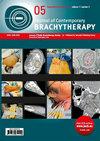印度放射肿瘤学家接受前列腺高剂量率近距离放射治疗的现状和未来准备情况:印度近距离放射治疗协会调查
IF 1.1
4区 医学
Q4 ONCOLOGY
引用次数: 0
摘要
目的:本调查旨在了解印度医生对前列腺近距离放射治疗的实践模式和态度。材料和方法:我们设计了一份21点的谷歌问卷,并通过短信、邮件和社交媒体发送给在印度执业的放射肿瘤学家。结果:共有来自 136 个中心的 212 名放射肿瘤学家回复了调查问卷,其中大多数(66%)接受过专业培训 > 6 年。我们发现,约 44.3%(n = 94)的受访者不从事任何部位的间质近距离治疗,大多数(83.3%,n = 175)不从事高剂量率(HDR)前列腺近距离治疗。只有 2.8%(n = 6)的医生倾向于使用近距离放射治疗,而 38.1%(n = 80)的受访者倾向于使用立体定向体放射治疗(SBRT)。当被问及在印度进行 HDR 前列腺近距离治疗的适应症时,32.5%(n = 67)的受访者倾向于单一疗法,46.1%(n = 95)的肿瘤学家认为增强疗法是一个很好的适应症,21.4%(n = 44)的受访者倾向于再照射/挽救疗法。在印度,前列腺近距离放射治疗未得到普及的最主要原因是缺乏培训(84.8%,n = 179)。调查还注意到,在80名采用SBRT前列腺增生治疗的受访者中,如果有足够的培训和设施,37名受访者更倾向于采用HDR近距离放射治疗。很明显,由于缺乏培训和基础设施,大多数放射肿瘤科医生没有开展 HDR 前列腺近距离治疗。如果组织专门的培训和研讨会,印度医生愿意学习并开始前列腺近距离治疗程序。本文章由计算机程序翻译,如有差异,请以英文原文为准。
Current status and future readiness of Indian radiation oncologists to embrace prostate high-dose-rate brachytherapy: An Indian Brachytherapy Society survey
Purpose:
This survey aimed to understand the practice pattern and attitude of Indian doctors towards prostate brachytherapy.
Material and methods:
A 21-point questionnaire was designed in Google form and sent to radiation oncologists practicing in India, using texts, mails, and social media. Responses were collated, and descriptive statistical analysis was performed.
Results:
A total of 212 radiation oncologists from 136 centers responded to the survey questionnaire, with majority (66%) being post-specialty training > 6 years. We found that about 44.3% (n = 94) of respondents do not practice interstitial brachytherapy for any site, and majority (83.3%, n = 175) do not practice high-dose-rate (HDR) prostate brachytherapy. Only 2.8% (n = 6) of doctors preferred boost by brachytherapy compared with 38.1% (n = 80) of respondents, who favored stereotactic body radiation therapy (SBRT) boost. When asked about the indication of HDR prostate brachytherapy in Indian setting, 32.5% (n = 67) of respondents favored monotherapy, 46.1% (n = 95) of oncologists thought boost as a good indication, and 21.4% (n = 44) preferred re-irradiation/salvage setting. The most cited reason for prostate brachytherapy not being popularly practiced in India was lack of training (84.8%, n = 179). It was also noted that out of 80 respondents who practiced SBRT for prostate boost, 37 would prefer HDR brachytherapy boost if given adequate training and facilities.
Conclusions:
The present survey provided insight on practice of prostate brachytherapy in India. It is evident that majority of radiation oncologists do not practice HDR prostate brachytherapy due to lack of training and infrastructure. Indian physicians are willing to learn and start prostate brachytherapy procedures if dedicated training and workshops are organized.
This survey aimed to understand the practice pattern and attitude of Indian doctors towards prostate brachytherapy.
Material and methods:
A 21-point questionnaire was designed in Google form and sent to radiation oncologists practicing in India, using texts, mails, and social media. Responses were collated, and descriptive statistical analysis was performed.
Results:
A total of 212 radiation oncologists from 136 centers responded to the survey questionnaire, with majority (66%) being post-specialty training > 6 years. We found that about 44.3% (n = 94) of respondents do not practice interstitial brachytherapy for any site, and majority (83.3%, n = 175) do not practice high-dose-rate (HDR) prostate brachytherapy. Only 2.8% (n = 6) of doctors preferred boost by brachytherapy compared with 38.1% (n = 80) of respondents, who favored stereotactic body radiation therapy (SBRT) boost. When asked about the indication of HDR prostate brachytherapy in Indian setting, 32.5% (n = 67) of respondents favored monotherapy, 46.1% (n = 95) of oncologists thought boost as a good indication, and 21.4% (n = 44) preferred re-irradiation/salvage setting. The most cited reason for prostate brachytherapy not being popularly practiced in India was lack of training (84.8%, n = 179). It was also noted that out of 80 respondents who practiced SBRT for prostate boost, 37 would prefer HDR brachytherapy boost if given adequate training and facilities.
Conclusions:
The present survey provided insight on practice of prostate brachytherapy in India. It is evident that majority of radiation oncologists do not practice HDR prostate brachytherapy due to lack of training and infrastructure. Indian physicians are willing to learn and start prostate brachytherapy procedures if dedicated training and workshops are organized.
求助全文
通过发布文献求助,成功后即可免费获取论文全文。
去求助
来源期刊

Journal of Contemporary Brachytherapy
ONCOLOGY-RADIOLOGY, NUCLEAR MEDICINE & MEDICAL IMAGING
CiteScore
2.40
自引率
14.30%
发文量
54
审稿时长
16 weeks
期刊介绍:
The “Journal of Contemporary Brachytherapy” is an international and multidisciplinary journal that will publish papers of original research as well as reviews of articles. Main subjects of the journal include: clinical brachytherapy, combined modality treatment, advances in radiobiology, hyperthermia and tumour biology, as well as physical aspects relevant to brachytherapy, particularly in the field of imaging, dosimetry and radiation therapy planning. Original contributions will include experimental studies of combined modality treatment, tumor sensitization and normal tissue protection, molecular radiation biology, and clinical investigations of cancer treatment in brachytherapy. Another field of interest will be the educational part of the journal.
 求助内容:
求助内容: 应助结果提醒方式:
应助结果提醒方式:


